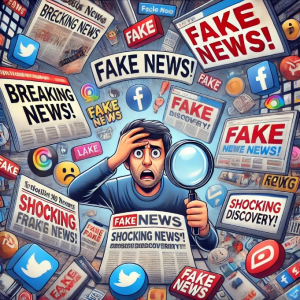Last updated on September 19, 2024

The many faces of deception
Fake news refers to false stories that look like real news, often spread online to influence opinions or as a joke.
Misinformation is incorrect information spread without intending to deceive.
Disinformation is intentionally false or misleading information meant to deceive or manipulate.
Malinformation is real information shared with the intention to cause harm.
“Rumor travels faster than the speed of light”
- Information spreads fast on social media and news, reaching lots of people quickly.
- Children are easily tricked by fake pictures and videos made by AI.
- Social media makes things worse by showing posts that get lots of likes or comments, even if they’re false.
- Even fake posts can be seen by more people because of this algorithmic promotion.
- People only see content that matches what they already believe, which creates an echo chamber.
- This makes it harder to see different opinions and increases the spread of false or harmful information.
How False information spreads
- Clickbait: Headlines designed to attract clicks, often contribute to misleading or incorrect information.
- Misleading Headlines: Sensational headlines that grab attention but don’t always match the article’s content.
- Propaganda: Political content meant to promote a certain view or spread false info about others.
- Satire: Humorous stories or graphics meant to make fun of things, often mistaken for real news.
- Parody: Comedic stories or content that humorously exaggerate or mock real events to entertain or criticize.
- Biased News: News that supports a specific viewpoint or belief to make a point.
Is there a way to identify and avoid false information?
It is very important to prevent the spread of false information and combat such news.
- Check who is behind the information: On social media, you can do this by looking at their profile or bio.
- Be doubtful: If an article uses mostly anonymous sources and lacks verified sources or proof, be doubtful of it.
- Read the whole article, not just the headline. Clickbait can be misleading.
- Use diverse sources.
- Think critically.
- Fact check with authorized fact checking websites.
- Be careful of deepfakes that look real but aren’t.
Sources:
https://www.nla.gov.au/faq/what-is-fake-news-misinformation-and-disinformation
https://www.internetmatters.org/issues/fake-news-and-misinformation-advice-hub/learn-about-fake-news-to-support-children/
https://csirt.uct.ac.za/awareness-cybersecurity-month-cybersecurity-month-2020/fake-news-misinformation-and-disinformation-same-same-or-different
https://www.security.org/digital-security/misinformation/

